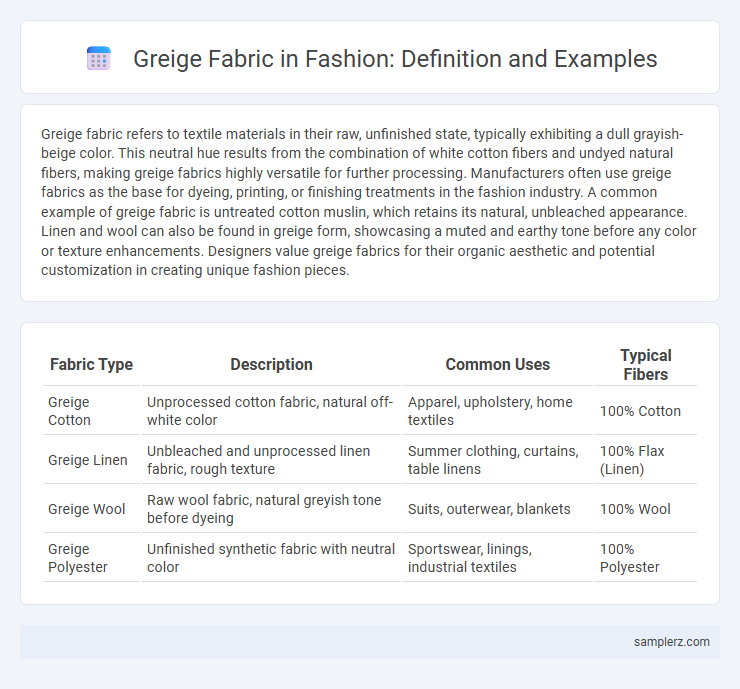Greige fabric refers to textile materials in their raw, unfinished state, typically exhibiting a dull grayish-beige color. This neutral hue results from the combination of white cotton fibers and undyed natural fibers, making greige fabrics highly versatile for further processing. Manufacturers often use greige fabrics as the base for dyeing, printing, or finishing treatments in the fashion industry. A common example of greige fabric is untreated cotton muslin, which retains its natural, unbleached appearance. Linen and wool can also be found in greige form, showcasing a muted and earthy tone before any color or texture enhancements. Designers value greige fabrics for their organic aesthetic and potential customization in creating unique fashion pieces.
Table of Comparison
| Fabric Type | Description | Common Uses | Typical Fibers |
|---|---|---|---|
| Greige Cotton | Unprocessed cotton fabric, natural off-white color | Apparel, upholstery, home textiles | 100% Cotton |
| Greige Linen | Unbleached and unprocessed linen fabric, rough texture | Summer clothing, curtains, table linens | 100% Flax (Linen) |
| Greige Wool | Raw wool fabric, natural greyish tone before dyeing | Suits, outerwear, blankets | 100% Wool |
| Greige Polyester | Unfinished synthetic fabric with neutral color | Sportswear, linings, industrial textiles | 100% Polyester |
Understanding Greige: The Unfinished Fabric
Greige fabric, also known as grey cloth, is the raw, unfinished textile produced directly from weaving or knitting, prior to any dyeing or finishing processes. Common examples include cotton greige, wool greige, and polyester greige, which retain their natural color and texture, offering designers a versatile base for customization. Understanding greige helps fashion professionals appreciate fabric qualities like hand feel, weight, and structure before treatment, ensuring better control over the final garment's appearance and performance.
Greige Fabric: Key Examples and Types
Greige fabric, an unprocessed textile, often includes cotton, linen, and wool in its raw state, offering a natural, neutral canvas for diverse fashion applications. Key examples of greige fabric types are greige cotton, which provides a soft, breathable foundation; greige linen, known for its textured, breathable qualities; and greige wool, valued for its warmth and durability before finishing treatments. These fabrics maintain their natural colors and fibers, enabling designers to customize their textures, weights, and dyes to achieve unique fashion aesthetics.
Popular Natural Fibers Used in Greige Fabric
Cotton, linen, and wool are popular natural fibers commonly used in greige fabric due to their durability and breathability. These fibers maintain the fabric's natural, unbleached appearance while offering excellent comfort and moisture-wicking properties. Silk also appears in greige textiles, valued for its smooth texture and strength, contributing to versatile fabric blends.
Greige in Cotton Textiles: A Closer Look
Greige cotton textiles, characterized by their unfinished, natural off-white color, serve as a versatile base in the fashion industry for dyeing and printing processes. This raw cotton fabric retains natural fibers and impurities, offering excellent breathability and durability while allowing designers to customize colors and patterns post-production. The use of greige cotton underscores sustainable fashion trends by reducing chemical treatments during fabric processing.
How Greige Linen Highlights Natural Beauty
Greige linen fabric showcases natural beauty by preserving the raw, unbleached fibers that highlight its organic texture and earthy tones. This neutral shade enhances the fabric's breathable quality and durability, making it a popular choice for sustainable fashion collections. Designers appreciate greige linen for its versatility, allowing it to blend effortlessly with bold colors and minimalist styles alike.
Synthetic Greige Fabrics: Polyester and Nylon Examples
Synthetic greige fabrics, such as polyester and nylon, serve as versatile raw materials in the fashion industry due to their durability and cost-effectiveness. Polyester greige fabric exhibits excellent wrinkle resistance and moisture-wicking properties, making it ideal for activewear and outerwear applications. Nylon greige fabric offers superior strength and abrasion resistance, often used in performance apparel and accessories requiring lightweight yet tough materials.
The Role of Greige in Sustainable Fashion
Greige fabric, characterized by its unbleached and undyed state, plays a pivotal role in sustainable fashion by reducing chemical use and water consumption during production. This natural, raw textile serves as an eco-friendly base for organic cotton, hemp, and linen, aligning with environmentally-conscious manufacturing practices. Designers leverage greige materials to create versatile, biodegradable garments that emphasize minimal processing and waste reduction.
Differences Between Greige and Dyed Fabrics
Greige fabric, also known as raw or unbleached fabric, retains its natural beige-gray color and lacks chemical treatment or dyeing, preserving the original fibers' texture and strength. Dyed fabrics undergo a chemical or natural dyeing process that introduces vibrant colors and patterns but may reduce the fabric's durability and alter its texture. The primary difference lies in greige fabric's untreated, neutral state versus dyed fabric's enhanced aesthetic appeal and potential changes in physical properties.
Creative Uses of Greige Fabrics in Modern Style
Greige fabrics, blending raw beige and gray tones, serve as a versatile foundation in modern fashion, allowing designers to experiment with texture and layering for a minimalist aesthetic. These neutral hues are embraced in outerwear and tailored pieces, highlighting natural fiber qualities like linen and wool that enhance sustainability and durability. Creative uses include combining greige with bold accessories or metallic accents to create sophisticated, contemporary looks that balance understated elegance with edgy style.
From Loom to Runway: Greige Fabrics in Fashion Collections
Greige fabrics, characterized by their unbleached, natural tone, serve as a versatile foundation in fashion collections, offering designers a raw canvas for creativity. These textiles transition seamlessly from loom to runway, allowing for customization through dyeing, printing, or finishing techniques that enhance texture and depth. The inherent neutrality and organic appeal of greige fabrics make them a popular choice in sustainable fashion lines and contemporary silhouettes.

example of greige in fabric Infographic
 samplerz.com
samplerz.com